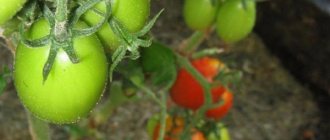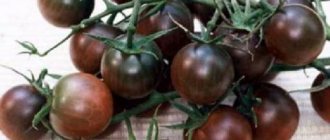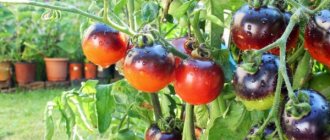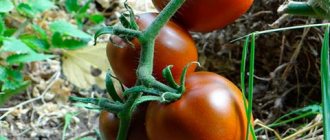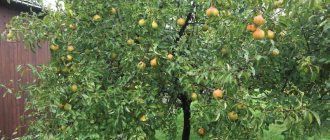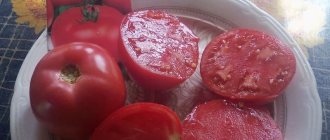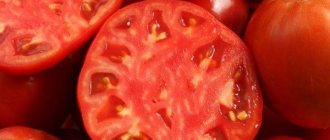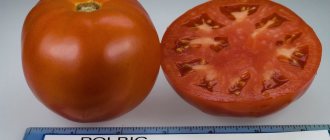Description of the variety
Fruit:
- Pear-shaped;
- Color varies from maroon to dark brown;
- With thin but dense skin;
- With fleshy, juicy skin-colored pulp;
- Average weight from 50 to 90 grams.
Bushes:
- Indeterminate, with a powerful, rigid body;
- They reach a height of 1.6 to 1.8 meters;
- The inflorescence is simple. The formation of the first occurs above the 9-10th leaf.
Description and characteristics of the species
All connoisseurs of unusual and tasty tomatoes will like the Black Pear tomato. It is not difficult to grow it, just follow the planting and care requirements. It all depends on the region of location, for example, Siberian weather requires cultivation under film cover.
Plant:
- Bush: indeterminate.
- Barrel: hard.
- Stem: powerful and thick.
- Height: 1.5-1.8 m.
- Ripening time (from seed planting to harvesting): 110-130 days.
- First inflorescence: above the 10th leaf.
- Fruiting: long.
Fetus:
- Shape: pear-shaped, has an external resemblance to a pear.
- Weight: 50-90 gr.
- Color: dark burgundy, dark brown.
- The pulp has the same color as the peel.
- Skin: thin.
- Density: high.
- Transportability: excellent.
A description of the tomato variety will help those who doubt the positive qualities of the plant make a choice. After reviewing the information, you can immediately conclude that the plant is useful and positively characterized. Those who planted this type of tomato on their plots were pleased with the results.
Tomatoes: advantages and disadvantages
Has the following advantages:
- Resistance to late blight;
- High carotene content;
- Excellent taste characteristics;
- Long-term fruiting;
- Commercial appearance of the fruit;
- Good keeping quality and transportability;
- Resistant to fruit cracking.
The disadvantages include:
- Increased demands on soil type;
- The need for stepsoning.
Benefits of Black Pear
This variety is distinguished not only by its shape, but also by its unusual coloring, as indicated by its name. The variety is not listed in the State Register of Breeding Achievements of the Russian Federation. According to available information, the tomato is suitable for open ground in the southern regions; in areas with short, cold summers it is grown indoors.
Gardeners love the tall Pear for its productivity, excellent taste of fruits, and resistance to disease. The advantages also include:
- Possibility of growing in open ground and in greenhouses (it all depends on the region). With proper agricultural technology, yields will be high everywhere.
- Black pear fruits are high in vitamins and carotene.
- Resistance to diseases (especially late blight, cladosporiosis).
- Long fruiting periods.
- Universal use. In mid-summer, you can use Pear in salads; closer to autumn, the fruits are canned and salted.
- Keeping quality (fruits do not crack, suitable for transportation).
- You can collect seeds from the fruits and use your own seed material for the next season.
Experienced gardeners who have grown black pear note that the tomato is very picky about soil quality. It does not tolerate acidified soil, which affects the color of the fruit. Therefore, when growing this variety, special attention should be paid to soil acidity indicators.
The requirement for regular feeding remains unchanged. The plant is powerful, large in height, produces a lot of fruit, so it is important to take care of 3-4 feedings during the growing season.
And despite the fact that the variety is resistant to diseases, you should not forget about preventive measures.
We hope that our information about the Black Pear tomato variety will be useful to you.
Natalia Severova
Growing tomatoes
It is preferable to grow through seedlings.
How to prepare seeds:
- Before sowing, a mandatory procedure is to check the seed material for germination. The seeds are placed in a 5% saline solution (a teaspoon of salt per 100 ml of water). Seeds that appear on the surface are not suitable for sowing;
- The high-quality planting material remaining at the bottom is soaked for 30 minutes in a pale solution of potassium permanganate. Then wash and dry.
IMPORTANT: Only self-collected seeds need pre-sowing preparation.
Sowing seed material:
- Seeds are sown between February and April;
- Containers for growing seedlings must have drainage holes and also be disinfected;
- To prepare the substrate, mix garden soil with humus in equal proportions. To destroy spores and bacteria, the soil mixture is steamed for 45 minutes in the oven at a temperature of +120 °C. It would also be a good idea to add coconut substrate, river sand, and vermiculite;
- Planting material is laid out on moist soil and sprinkled with dry soil;
- The container is covered with film. The seedlings are regularly ventilated; when the soil dries, the soil is moistened with a spray bottle. Maintain the room temperature at least +20 °C;
- As soon as the shoots emerge, remove the film. Then the seedlings are provided with 10-12 hours of daylight and maintain a temperature no higher than +18 °C. After 7 days, the temperature during the day should be +23...+25 °C, and at night within +18...20 °C;
- When two true leaves are formed, the seedlings are picked and fed with complex mineral fertilizer;
- Water as needed, fertilize once every 2 weeks;
- For better adaptation to a new location, seedlings are hardened off within 14 days before transplantation.
Rules for planting seedlings:
- Seedlings are transplanted to a permanent place at the age of 50-70 days. Specific dates are determined by the climatic and weather conditions of the growing region;
- It is better to choose a sunny site, protected from cold winds. The preparation of the beds begins a few days before transplanting. The soil is dug up, at the same time adding humus and compost, and also getting rid of weeds;
- The seedlings are planted in completely heated soil. The optimal time is evening;
- When planting, the following scheme is observed: row spacing - 70 cm, interval between bushes - 30 cm. Planting holes are watered abundantly with warm water; the use of a pale pink manganese solution is allowed. In advance, stakes (1.5 -1.7 m) are installed near the holes for further gartering of bushes;
- After complete absorption of moisture, transplantation begins. Tomato bushes are planted together with a lump of earth, after watering abundantly;
- Planted seedlings are watered abundantly.
Description:
How to grow tomatoes without seedlings?
Both open ground and greenhouses are suitable for growing black pear tomatoes. If we talk about planting rules, there are no strong differences from working with traditional tomatoes. When resorting to growing without seedlings, the gardener is advised to pay attention to the following factors:
- Soil preparation. Loose, fertile soils are suitable for tomatoes. During gardening, you should take care of applying phosphorus and potassium fertilizers. Wood ash is perfect - at the rate of 2 kg per 1 square meter. Then you need to properly dig up the soil layer.
- Maintaining distances. Between seedlings it is necessary to maintain a distance of at least 0.4 meters. This must be taken into account when sowing. If the plants are too close to each other, this will negatively affect the amount of harvest.
- Care after landing. The place with black tomatoes needs abundant watering, which will require warm water. Then the bed is covered with plastic film. The covering material can be removed when the weather outside is good, not cold.
- As soon as the seeds germinate, you should start thinning the bushes as needed.
Bush care
Recommendations for further care:
- The plantings are fed for the first time two weeks after transplantation. Slurry (half a liter of mullein per 10 liters of water), chicken manure granules, and humic preparations are used as fertilizer. The following feedings are carried out during the period of flowering and fruit formation;
- The frequency of watering is determined by climatic conditions and dry soil. As the soil dries, water it. Watering is carried out once a week. During the rainy season, watering is stopped. Moisture deficiency causes fruit ovaries to fall off and also leads to cracking of ripened fruits;
- To get a good harvest, the bush is formed into two stems. It is recommended to form the bush on a trellis. The bushes also need tying up. To lengthen the fruiting period, pinch the top after 7-8 clusters have formed.
Features of growing and planting tomatoes Black pear
Seedlings are planted in beds according to a 40x60 cm pattern, placing up to 4 plants per 1 m2. The stems are tied with twine to the supports. The seed manufacturer advises forming a bush into one stem. To do this, you need to remove all side shoots. He also recommends removing the lower leaves, which are most often affected by infections from their contact with periodically moistened soil.
At the end of the growing season, the growing point of the tomato is plucked off so that the remaining fruits on the bush ripen faster. Care consists of timely watering and regular feeding. During the entire growing season, fertilizers must be applied at least three times. The main emphasis should be on phosphorus and potassium. As necessary, plants are treated against fungal infections and pests. Tomatoes respond well to loosening the soil, hilling and mulching with straw.
I work in a rural school. And in the teachers' lounge every now and then there is a conversation about the vegetable garden. One day a new teacher got a job with us. She often brought tomatoes with her and treated the whole team. They began to extort the secret of a bountiful harvest from her. It turned out that she sprays and waters the tomatoes with yeast. To prepare the solution, you need 10 g of dry or 20 g of compressed yeast, a bucket of water and 30 g of sugar. Before use, you need to let it sit for 2-3 hours. Plants should be treated twice a month.
Video: caring for seedlings after emergence and picking seedlings
Diseases and pests
Prevention and treatment of major diseases:
- Blackleg. The causative agent of the disease is a fungus that attacks the stems and foliage of the crop. As preventive measures, it is recommended to plant seedlings at a fairly far distance from each other, as well as reduce watering. During digging, trichodermin is added to the soil;
- Fusarium. Young bushes in greenhouses are most susceptible to the disease. A fungal disease occurs as a result of elevated temperatures and lack of lighting. Affected plants are removed along with the root ball of earth. The remaining seedlings are sprayed with a phytosporin solution.
Common pests:
- Whitefly. A frequent guest in greenhouse structures, where it penetrates along with the air flow. As a preventative measure, the windows are covered with gauze. You can also plant tobacco, the leaves of which have been treated with Actellik, near tomato bushes;
- Spider mite. It is most dangerous in hot weather. It takes not in size, but in quantity. After sucking out all the juices, the leaves become “marbled”.
Spraying with Fitoverm is quite effective, with strict adherence to the instructions on the packaging.
Opinions of experienced and novice gardeners
Doubts about planting a certain variety of tomato are often resolved by searching for an answer on the Internet. Reviews from people who grew Black Pear:
- Oksana. He believes that tomatoes are best eaten fresh. Since due to their delicate skin they cannot be preserved.
- Marina. I grew various varieties of pear-shaped tomatoes and was very pleased with the results and characteristics of the plant.
- Galina. An attempt to grow a Black Pear tomato on the plot was unsuccessful. After the fruits appear, the plant begins to rot.
- Elena. I accidentally grew several plants on my plot. I didn’t read the description, so the recommendations were not taken into account. She raised several stepsons, forming a bush with 4 trunks. I collected 2 buckets of tomatoes from each. The consecration was sufficient; the distance between plants was about 70 cm.
Reviews about the variety from those who planted
Review from a gardener: Many gardeners characterize the tomato variety “Black Pear” on the positive side, taking into account the fact that if the recommendations on agricultural technology are not followed, you may not get a good harvest. Owners of personal plots who received a bountiful harvest prefer to continue growing this variety.
The tomato variety “Black Pear”, distinguished by its excellent taste, will certainly decorate any garden plot. A wide variety of dishes can be prepared from ripe fruits.
Positive and negative aspects of the variety
The black pear tomato has its strengths and weaknesses, like any other tomato variety.
Pros:
- Contains carotene and vitamins C and A.
- Contains antioxidants.
- The anthocyanins they contain help strengthen the immune system.
- Lycopenes prevent the occurrence of tumors.
- Not susceptible to late blight, rot and cladosporiosis.
- It is well stored and retains its presentation for a long time.
- The fruiting process is quite long.
- Productivity is high.
- The fruits do not crack.
- The taste is high.
Minuses:
- It is imperative to remove the stepsons.
- Demanding on soil composition.
Reviews
I grew black pear for 2 years. The first summer was rainier - the pear tasted rather bland, but last summer, in the sun and heat, it was very sweet. But both years the bushes were productive without green butts. And every infection is one of the last to catch. Ripe ones can be stored for 2 weeks, but they wrinkle a little. I plant it at the end of May under arches in the exhaust zone. By the end of August, the first and second clusters ripen completely on the bush.
tasha
https://www.tomat-pomidor.com/forums/topic/464-%D0%B1%D0%B5%D0%B4%D1%83%D0%B8%D0%BD-%D0%B3%D1% 80%D1%83%D1%88%D0%B0-%D1%87%D1%91%D1%80%D0%BD%D0%B0%D1%8F/
The seeds sprouted quickly and at the beginning of May the bushes were planted in a greenhouse. Since we were away for two months, a lot of ovaries, including parasitic ones, formed and some of the tomatoes became smaller. This did not affect the taste or yield in any way.
SKLana
https://otzovik.com/review_5455748.html
I liked the variety, it grew in open ground, the fruits first have greenery at the stalk, and after ripening (ripening) they are completely colored. The result was a mid-season black pear that withstood the heat and wind well.
Lana_s_Kavkaza
www.tomat-pomidor.com/forums/topic/464-bedouin-pear-black/
Black pear is a high-yielding tomato variety that consistently bears fruit both in greenhouses and in open ground. Its high taste and high sugar content in the pulp are combined with relatively small fruit. This is the main advantage of tomatoes, thanks to which they can be used for various purposes.
